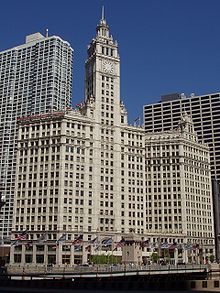
Graham, Anderson, Probst & White
Encyclopedia

Daniel Burnham
Daniel Hudson Burnham, FAIA was an American architect and urban planner. He was the Director of Works for the World's Columbian Exposition in Chicago. He took a leading role in the creation of master plans for the development of a number of cities, including Chicago and downtown Washington DC...
's surviving partner Ernest Graham
Ernest R. Graham (architect)
Ernest Robert Graham was an American architect from Chicago. He was the co-founder of Graham, Anderson, Probst & White. He designed the National Postal Museum in Washington, D.C. and the Equitable Building in in New York City...
and Burnham's sons Hubert Burnham and Daniel Burnham Jr. In 1917, the Burnhams left to form Burnham Brothers, and Graham and the others, (William) Peirce Anderson, Edward Mathias Probst, and Howard Judson White formed the current firm.
Background
Graham, Anderson, Probst and White was the largest architectural firm under one roof in the first half of the twentieth century. Their importance to Chicago's architectural legacy cannot be overstated. This one firm seemed to capture the majority of the big commissions from 1912 to 1936, including such iconic works as the Wrigley BuildingWrigley Building
The Wrigley Building is a skyscraper located directly across Michigan Avenue from the Tribune Tower on the Magnificent Mile...
, Merchandise Mart
Merchandise Mart
When opened in 1930, the Merchandise Mart or the Merch Mart, located in the Near North Side, Chicago, Illinois, was the largest building in the world with of floor space. Previously owned by the Marshall Field family, the Mart centralized Chicago's wholesale goods business by consolidating vendors...
, Field Museum, Shedd Aquarium
Shedd Aquarium
The John G. Shedd Aquarium is an indoor public aquarium in Chicago, Illinois in the United States that opened on May 30, 1930. The aquarium contains over 25,000 fish, and was for some time the largest indoor aquarium in the world with of water. The Shedd Aquarium was the first inland aquarium with...
, Civic Opera House, and the old main Chicago post office
Chicago post office
The Old Chicago Main Post Office is a nine-story-tall building in Chicago designed by Graham, Anderson, Probst & White and built in 1921. The original structure was a brick-sided mail terminal building, still sited just east of the main building that engulfs Eisenhower Expressway as it turns into...
. They also created the iconic Terminal Tower
Terminal Tower
The Terminal Tower is a landmark skyscraper located on Public Square in downtown Cleveland, Ohio. It was built during the skyscraper boom of the 1920s and 1930s, and was the second-tallest building in the world when it was completed. The Terminal Tower stood as the tallest building in North America...
in Cleveland
Cleveland, Ohio
Cleveland is a city in the U.S. state of Ohio and is the county seat of Cuyahoga County, the most populous county in the state. The city is located in northeastern Ohio on the southern shore of Lake Erie, approximately west of the Pennsylvania border...
and Federal Reserve Bank
925 Grand
925 Grand is the former headquarters of the Federal Reserve Bank of Kansas City and was the oldest building in active use of any Federal Reserve Bank. It was added to the National Register of Historic Places in 2007....
in Kansas City
Kansas City, Missouri
Kansas City, Missouri is the largest city in the U.S. state of Missouri and is the anchor city of the Kansas City Metropolitan Area, the second largest metropolitan area in Missouri. It encompasses in parts of Jackson, Clay, Cass, and Platte counties...
. Mr. Anderson died in 1924, with Graham and White following just weeks apart in 1936. Surviving partner Probst took over the firm, assisted by his sons Marvin and Edward E. Probst.
After Mr. Probst's death in 1942, his son Marvin G. Probst took over as firm president. Edward E. Probst left the firm about 1947. Just prior to Marvin's death in 1970, the firm was sold to an employee, William R. Surman and since his death in 1993, it was being run by his son Robert Surman. The firm is now out of business.
The firm is known for its classical taste and the elegance of its Beaux-Arts-inspired output that has withstood multiple generations of critics. Their buildings are still popular favorites.
Architectural sculpture
Like most of the other prominent architectural firms of the early 20th Century GAP&W frequently used sculpture to decorate their buildings. Like many of the other firms of the era GAP&W had specific artists that they preferred to work with. One in particular was New Yorker Henry HeringHenry Hering
Henry Hering was an American sculptor who was born New York City on February 15, 1874 and died there on January 17, 1949.-Early career:He was a student of Augustus Saint-Gaudens at Cooper Union and of Philip Martiny at the Art Students League of New York...
who created the sculptured pediment for the Civic Opera House, a variety of details for the Field Museum, including a variation on the Erectheum porch, as well as the allegorical figures Day and Night in the Great Room of the Chicago Train Station. As the century progressed the firm moved away from the classical style used by Hering to more contemporary art deco
Art Deco
Art deco , or deco, is an eclectic artistic and design style that began in Paris in the 1920s and flourished internationally throughout the 1930s, into the World War II era. The style influenced all areas of design, including architecture and interior design, industrial design, fashion and...
styled work as that attributed to sculptor Frank Jirouch on Cleveland's Midland Building.

